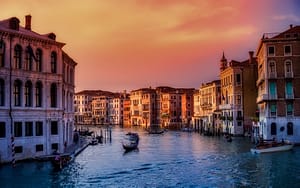Museums
Doge’s Palace
Also called the Palazzo Ducale, the Doge’s Palace sits right on the Piazza San Marco and is, in fact, an exhaustive collection of smaller museums, a courtyard, and a trove of over-the-top ornamentation, including frescoed walls, gilded ceilings, and intricately carved statues and friezes. Part palace and part fortress, the Doge’s Palace held both the home of the Doge and, for a while, the city’s prison.
Museo Civico Correr
Also located on Piazza San Marco, the Museo Correr is dedicated to Venice’s civic history. The museum is named after Venetian aristocrat Teodoro Correr, whose last will and testament bequeathed many of the items in the collection, including paintings, drawings, copperplates, coins, seals, and classical antiquities. Of particular interest in the Museo Correr are the fine marble sculptures by Antonio Canova and the many paintings and drawings of the Venetian cityscape as it has changed through the centuries.
Ca’Rezzonico
Venice’s largest cache of 18th-century art is located in the Ca’Rezzonico, which is named after the patrician Rezzonico family. Their former Baroque palace on the Grand Canal displays three floors of paintings, sculpture, and decadent furnishings as well as four rooms containing significant works by Giambattista Tiepolo.
Peggy Guggenheim Collection
Most of the artworks in the Peggy Guggenheim Collection, among Italy’s most important museums for modern art, were acquired by American socialite Peggy Guggenheim, who was a patron of the arts throughout her lifetime. The museum contains works from the most famous European and American artists of the first half of the 20th century, including Pablo Picasso, Jackson Pollock, and Alexander Calder, and it also hosts special exhibitions throughout the year.
Galleria dell’Accademia
Not to be confused with the Accademia in Florence, which houses Michelangelo’s David and a lot of Tuscan art, Venice’s Galleria dell’Accademia boasts its own stunning treasures, most of which are of Venetian heritage. The greats of Venetian painting from the 14th to the 18th centuries are represented, including Paolo Veneziano, Giovanni Bellini, Giorgione, Titian, and Tiepolo.
Parks
Giardini Pubblici
Also known as the Giardini Napoelonici or Giardini Biennale (since they sometimes host Biennale art and sculpture exhibits), the largest patch of green space in Venice consists of formal public gardens way out near the far end of the Castello neighbourhood.
Giardini Papadopoli
In the corner formed by two canals, just across the footbridge from Piazzale Roma, this 19th century park was laid out by a set-painter for La Fenice opera house.
Giardinetti Reali
The Venice park hidden in plain sight: a pocket-sized garden wedged between Piazza San Marco and the Grand Canal—once part of Napoleon’s royal palace, now zipped past by many visitors.
Giardini Savorgnan
Giardini Savorgnan was laid out in the late 1600s as the private gardens for Palazzo Savorgnan (now a school). It provides a cool, refreshing spot near the train station to stroll under linden, chestnut, plane trees, oak.
Parco di Villa Groggia
At the northern edge of Cannaregio, this small Romantic-style park of laurel and palm trees houses a ludoteca (small children’s play center), pool, and a tiny 19th-century theater.
Markets
Mercato Biologico Solidale Aeres
This market on Rio Tera dei Pensieri close to Piazzale Roma is open during the season on Thursdays, from 10:30 am to 6:30 pm and it is founded on progressive notions of good food produced ethically and consumed conscientiously. Some of the produce sold here is grown by the women in the penitentiary on Giudecca island. Everything grown here is truly different from any other market because it’s produced in small batches and each fruit and vegetable is full of flavor.
Rialto market
This is the heart of Venice, where vendors sell fresh seafood as well as produce. It’s open every day of the week except Sunday. It’s the best way to see the city’s vibrant social life, especially on Saturday mornings when everyone comes to do their grocery shopping. Pick up some fruit to munch on and have a snack at the nearby bar, Al Merca’.
Calle Longhi
This is a farmer’s market that happens every Monday on Calle Longhi in Santa Marta. In season, you’ll be able to taste locally grown asparagus from Giare, honey from the marshy islands of the lagoon and castraure, the baby artichoke buds from Sant’Erasmo. You’ll also get to meet the producers and growers directly.
Campo San Barnaba
The boat on the canal in front of Campo San Barnaba carries all your produce and fruit for every day cooking. Beloved in the neighborhood, it’s been here in the same location for over 70 years. It’s open all week except Sunday, but don’t expect to pick up anything during lunchtime.
Mestre market
In the center of Mestre, in and around Piazza Barche, there’s a huge market held every Wednesday and Friday. There’s the usual fruit and vegetable market, but also flowers, specialty meat and cheese stands, as well as vendors selling sandwiches and roasted chickens. You’ll also get to shop for household items, shoes, and clothing.

